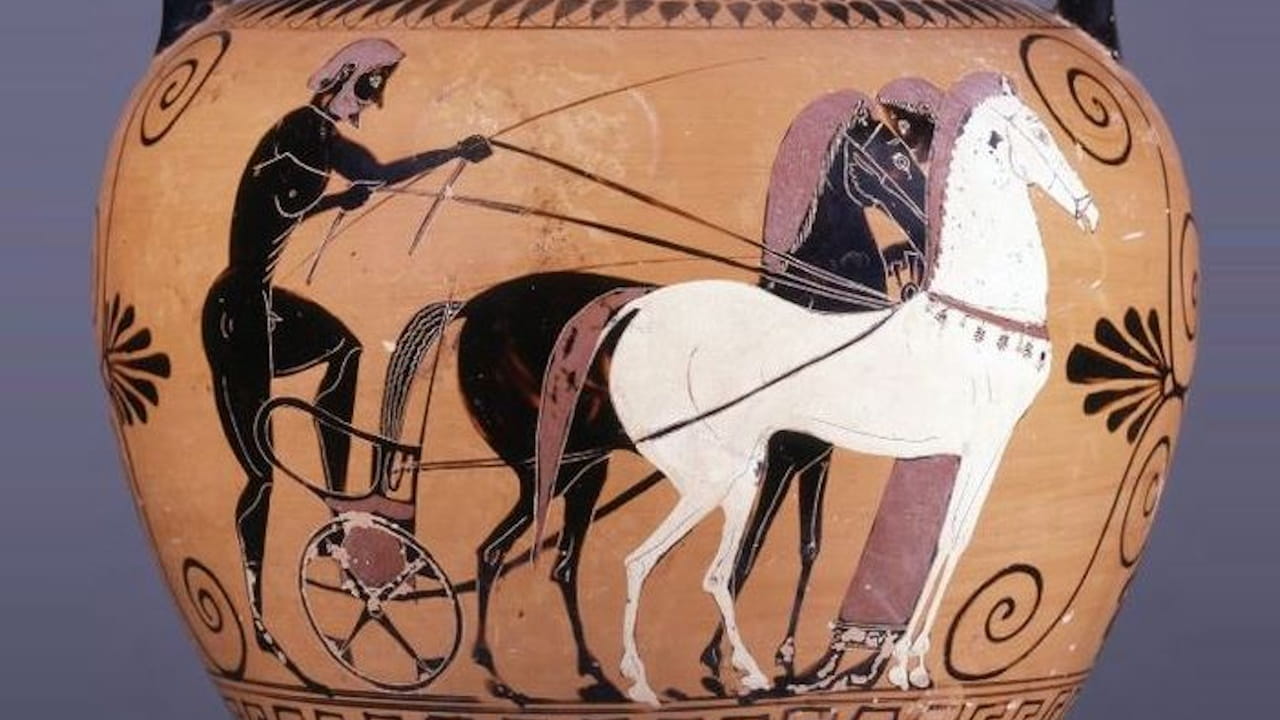Today we are going to review the Myth of the Winged Chariot. A concept of Platonic philosophy that has been used as a resource in countless works.

what is the Myth of the Winged Chariot?
The myth of the winged chariot is an ancient narrative found in Platonic philosophy and is presented in the dialogue“Phaedrus“, written by the Greek philosopher Plato. In this myth, Plato describes the human soul as a winged chariot driven by a charioteer (driver) consisting of two horses, one noble and one of an inferior nature.
The chariot as a symbol
The charioteer represents reason or the human mind, while the two horses symbolize the opposing forces within each individual: the noble horse represents noble impulses, such as virtue, courage and self-control; while the horse of a lower nature represents worldly desires and unbridled passions.
The charioteer’s task is to guide these two horses towards the supreme goal: to attain truth and wisdom. The noble horse helps in this journey by being docile and collaborative, while the lower horse tends to be undisciplined and deviate from the right path.
The myth of the winged chariot is used as a metaphor to illustrate the inner struggle of the human being between rational impulses and irrational desires, as well as the importance of mastering these opposing forces to achieve true wisdom and inner well-being.
Figures in the Myth of the Winged Chariot
As we have commented, this myth represents the internal struggle of the human being between his rational impulses and his irrational desires. Within its composition we find figures that incite self-regulation and self-mastery to achieve moral and spiritual excellence.

The Auriga
The charioteer is the driver of the winged chariot and represents reason or the human mind. He is responsible for guiding and directing the chariot towards its goal. He symbolizes rational power and the ability to make conscious and rational decisions.
The Noble Horse
This horse symbolizes the noble and virtuous impulses of the soul, such as courage, virtue and self-control. It represents the positive aspects of human nature and its willingness to follow the right path to truth and wisdom. It is docile and collaborative, facilitating the chariot’s journey.
The Horse of Inferior Nature
This horse represents worldly impulses and desires, unbridled passions and uncontrolled emotions. It symbolizes the darker and less desirable aspects of human nature, which can lead the soul astray from the right path and hinder its search for truth and wisdom.
Interpretation of the colors in the chariot
Normally, the colors imply symbolism in the conflict between reason and passions. Normally in all the images of this myth, similar concepts are resorted to.
- Auriga: Often associated with the color white or gold, representing purity, mental clarity and wisdom.
- Noble horse: Often linked with the color white, silver or gold, symbolizing virtue, nobility and goodness.
- Horse of inferior nature: Sometimes related to dark colors such as black or red, suggesting uncontrolled passions, less desirable impulses or dark aspects of human nature.

Representation of the Winged Chariot in Culture
The myth of the winged chariot, as described in Plato’s “Phaedrus” dialogue, has been a source of inspiration and has influenced numerous literary, philosophical and cultural works throughout history. Although not directly replicated in other works, its influence has permeated literature and philosophy, manifesting itself in different forms and adaptations.
Works where the influence of the winged chariot can be perceived
- Later philosophical works: Many philosophers after Plato, such as Plotinus, Porphyry and the Neoplatonists, took up elements of this myth and discussed it in their own works.
- Medieval and Renaissance literature: During the Middle Ages and the Renaissance, the myth of the winged chariot influenced various writings and allegories, particularly works of philosophy and literature that addressed issues of ethics, morality and the nature of the soul.
- Influence on modern literature: Later authors, such as Dante Alighieri in “The Divine Comedy”, and William Blake in his poetry and engravings, have incorporated symbolic and philosophical elements similar to those present in Plato’s winged chariot myth.
- References in contemporary culture: Although not directly replicated, the concept of the inner conflict between rational and emotional impulses has inspired the creation of contemporary stories and films that explore human duality and the inner struggle for redemption, wisdom or self-control.

